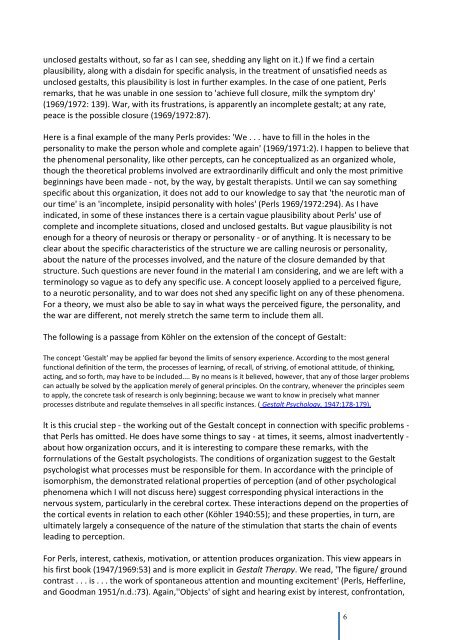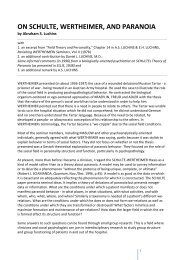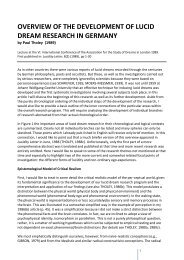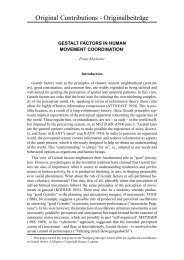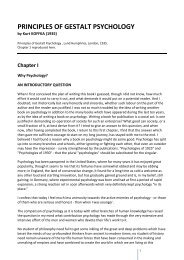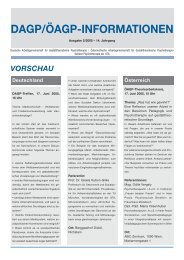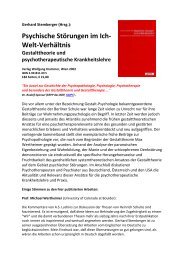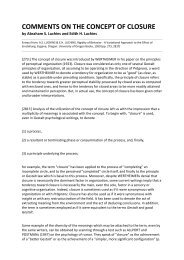Mary HENLE - Society for Gestalt Theory and its Applications (GTA)
Mary HENLE - Society for Gestalt Theory and its Applications (GTA)
Mary HENLE - Society for Gestalt Theory and its Applications (GTA)
- No tags were found...
You also want an ePaper? Increase the reach of your titles
YUMPU automatically turns print PDFs into web optimized ePapers that Google loves.
unclosed gestalts without, so far as I can see, shedding any light on it.) If we find a certainplausibility, along with a disdain <strong>for</strong> specific analysis, in the treatment of unsatisfied needs asunclosed gestalts, this plausibility is lost in further examples. In the case of one patient, Perlsremarks, that he was unable in one session to 'achieve full closure, milk the symptom dry'(1969/1972: 139). War, with <strong>its</strong> frustrations, is apparently an incomplete gestalt; at any rate,peace is the possible closure (1969/1972:87).Here is a final example of the many Perls provides: 'We . . . have to fill in the holes in thepersonality to make the person whole <strong>and</strong> complete again' (1969/1971:2). I happen to believe thatthe phenomenal personality, like other percepts, can he conceptualized as an organized whole,though the theoretical problems involved are extraordinarily difficult <strong>and</strong> only the most primitivebeginnings have been made - not, by the way, by gestalt therapists. Until we can say somethingspecific about this organization, it does not add to our knowledge to say that 'the neurotic man ofour time' is an 'incomplete, insipid personality with holes' (Perls 1969/1972:294). As I haveindicated, in some of these instances there is a certain vague plausibility about Perls' use ofcomplete <strong>and</strong> incomplete situations, closed <strong>and</strong> unclosed gestalts. But vague plausibility is notenough <strong>for</strong> a theory of neurosis or therapy or personality - or of anything. lt is necessary to beclear about the specific characteristics of the structure we are calling neurosis or personality,about the nature of the processes involved, <strong>and</strong> the nature of the closure dem<strong>and</strong>ed by thatstructure. Such questions are never found in the material I am considering, <strong>and</strong> we are left with aterminology so vague as to defy any specific use. A concept loosely applied to a perceived figure,to a neurotic personality, <strong>and</strong> to war does not shed any specific light on any of these phenomena.For a theory, we must also be able to say in what ways the perceived figure, the personality, <strong>and</strong>the war are different, not merely stretch the same term to include them all.The following is a passage from Köhler on the extension of the concept of <strong>Gestalt</strong>:The concept '<strong>Gestalt</strong>' may be applied far beyond the lim<strong>its</strong> of sensory experience. According to the most generalfunctional definition of the term, the processes of learning, of recall, of striving, of emotional attitude, of thinking,acting, <strong>and</strong> so <strong>for</strong>th, may have to be included.... By no means is it believed, however, that any of those larger problemscan actually be solved by the application merely of general principles. On the contrary, whenever the principles seemto apply, the concrete task of research is only beginning; because we want to know in precisely what mannerprocesses distribute <strong>and</strong> regulate themselves in all specific instances. ( <strong>Gestalt</strong> Psychology, 1947:178-179).lt is this crucial step - the working out of the <strong>Gestalt</strong> concept in connection with specific problems -that Perls has omitted. He does have some things to say - at times, it seems, almost inadvertently -about how organization occurs, <strong>and</strong> it is interesting to compare these remarks, with the<strong>for</strong>rnulations of the <strong>Gestalt</strong> psychologists. The conditions of organization suggest to the <strong>Gestalt</strong>psychologist what processes must be responsible <strong>for</strong> them. In accordance with the principle ofisomorphism, the demonstrated relational properties of perception (<strong>and</strong> of other psychologicalphenomena which I will not discuss here) suggest corresponding physical interactions in thenervous system, particularly in the cerebral cortex. These interactions depend on the properties ofthe cortical events in relation to each other (Köhler 1940:55); <strong>and</strong> these properties, in turn, areultimately largely a consequence of the nature of the stimulation that starts the chain of eventsleading to perception.For Perls, interest, cathexis, motivation, or attention produces organization. This view appears inhis first book (1947/1969:53) <strong>and</strong> is more explicit in <strong>Gestalt</strong> Therapy. We read, 'The figure/ groundcontrast . . . is . . . the work of spontaneous attention <strong>and</strong> mounting excitement' (Perls, Hefferline,<strong>and</strong> Goodman 1951/n.d.:73). Again,''Objects' of sight <strong>and</strong> hearing exist by interest, confrontation,6


